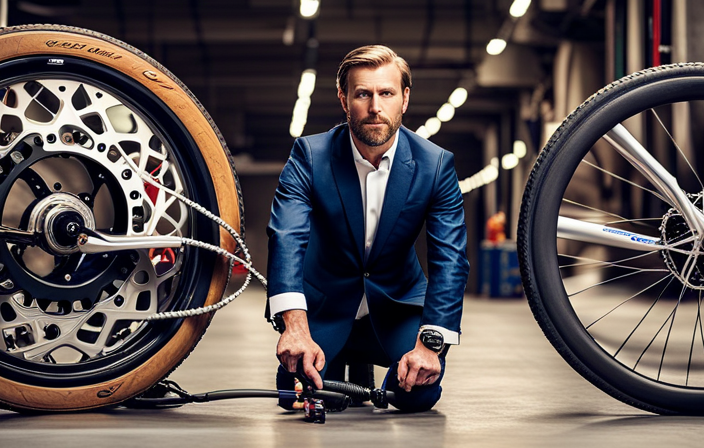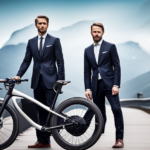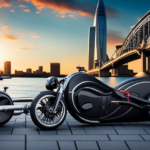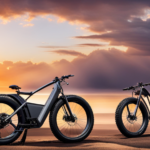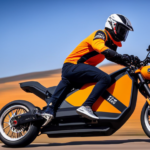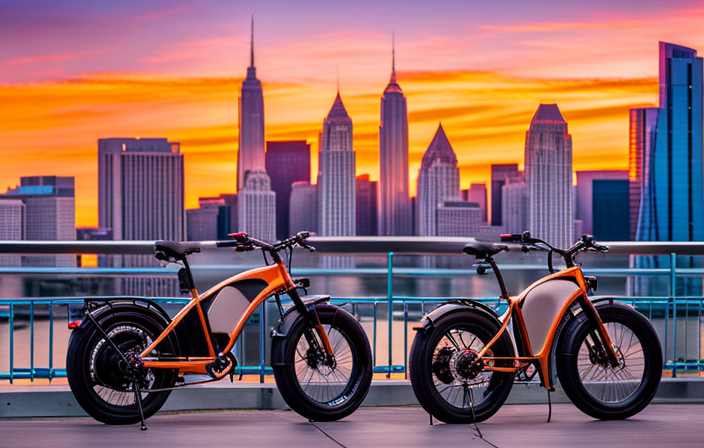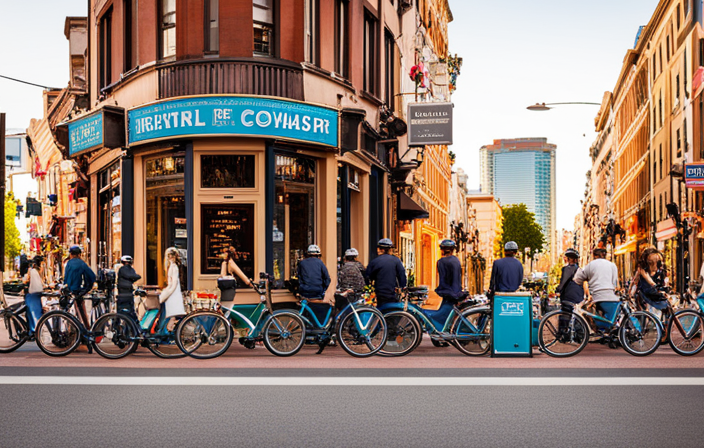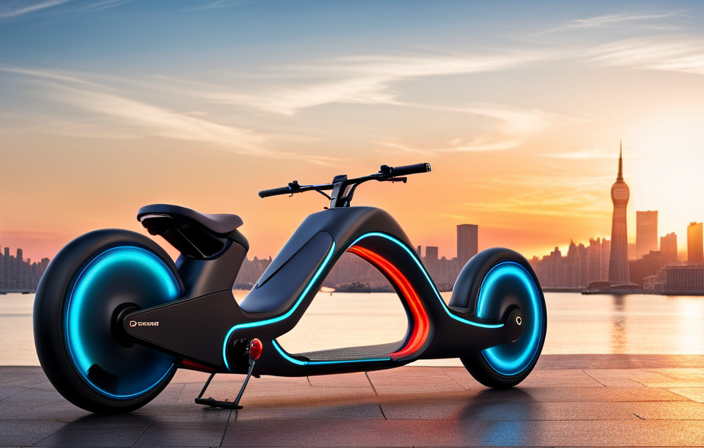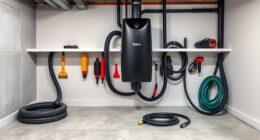Have you ever wished you could effortlessly glide up hills and conquer long distances on your road bike? Well, I have good news for you: adding an electric motor to your road bike can make that dream a reality.
By equipping your bike with an electric motor kit, you can enhance your cycling experience and go faster and farther with ease. In this article, I will guide you through the process of adding an electric motor to your road bike, providing you with all the necessary information and steps to transform your bike into an electric-assisted powerhouse.
Key Takeaways
- Consider power output, frame compatibility, and motor type when choosing an electric motor kit for a road bike
- Familiarize yourself with all kit components and ensure bike compatibility before installation
- Properly install the motor by following the mounting instructions and ensuring all connections are secure
- Test and adjust the motor’s behavior, troubleshoot any issues, and adjust settings for optimal performance and enjoyment
Assess Your Bike’s Compatibility
Before you start, make sure your bike’s frame is compatible with an electric motor. Evaluating compatibility is crucial to ensure a successful conversion.
Begin by checking your bike’s specifications, including the frame type, size, and material. Electric motors typically require a certain frame design to accommodate the necessary components, such as a motor mount or battery placement. Look for a frame with enough space to install the motor without interfering with other bike parts.
Additionally, consider the weight and balance of your bike, as adding an electric motor may affect its handling and stability.
Research different types of electric motors to find one that suits your bike’s compatibility and your riding needs.
Research Different Types of Electric Motors
Start by exploring various options for different types of motors that can be installed on your bicycle. There are several motor technologies available in the market that you can consider for your road bike conversion project.
Here are three types of electric motors that you should research and compare:
-
Hub Motors: These motors are integrated into the wheel hub and provide direct drive. They are easy to install and maintain, but they can add weight to your bike, affecting its handling.
-
Mid-drive Motors: These motors are installed near the bike’s bottom bracket and power the crankshaft directly. They offer better weight distribution and greater torque for climbing hills, but they can be more complex to install.
-
Friction Drive Motors: These motors use a roller that presses against the bike’s tire to provide propulsion. They are lightweight and easy to install, but they can wear out tires faster and may require more maintenance.
By exploring different motor technologies and comparing their efficiency, you can make an informed decision about the best motor for your road bike conversion.
Transitioning into the next section, let’s now move on to choosing the right electric motor kit for your bike.
Choose the Right Electric Motor Kit
To choose the right electric motor kit for your bicycle, you need to consider factors such as your preferred motor technology and the specific requirements of your conversion project. Researching different electric motor brands is crucial in order to find the one that meets your needs. Take the time to compare prices and features to ensure you are getting the best value for your money. To help you visualize the options available, here is a comparison table of five popular electric motor kits:
| Electric Motor Kit Brand | Motor Technology | Price Range | Features |
|---|---|---|---|
| Brand A | Brushless | $300-$500 | High torque, long battery life |
| Brand B | Geared | $200-$400 | Lightweight, compact design |
| Brand C | Direct Drive | $400-$600 | Quiet operation, high top speed |
| Brand D | Mid Drive | $500-$700 | Excellent hill climbing ability |
| Brand E | Hub Motor | $250-$450 | Easy installation, smooth ride |
Once you have chosen the right electric motor kit, you can proceed to the next step of gathering the necessary tools and equipment for the installation process.
Gather the Necessary Tools and Equipment
Before starting the installation of an electric motor kit on a road bike, it’s important to gather all the necessary tools and equipment. This includes a set of allen wrenches, screwdrivers, pliers, and a torque wrench.
Additionally, it’s crucial to ensure that you have all the necessary components for the installation, such as the motor, battery, controller, and wiring harness.
Lastly, preparing a clean and organized workspace will make the installation process much easier and efficient, allowing for better accessibility and reducing the risk of losing or misplacing any components.
Make a list of tools required for the installation
You’ll need a variety of tools to complete the installation of an electric motor on your road bike. Adding an electric motor to a road bike offers numerous benefits, including increased speed and the ability to tackle hills with ease. However, it is important to be aware of the common challenges faced during the installation process.
To ensure a successful installation, you will need tools such as a wrench set, screwdrivers, Allen keys, wire cutters and strippers, and a torque wrench. These tools will enable you to properly secure the motor and connect the necessary wiring. Additionally, it is recommended to have a bike stand or repair stand to hold your bike steady during the installation.
With these tools in hand, you can ensure you have all the necessary components for a smooth and efficient installation process.
Ensure you have all the necessary components
Make sure you have all the required components for the installation. Here is a list of essential items you will need to assess compatibility and gather tools:
-
Electric Motor Kit: Choose a motor kit that is compatible with your road bike’s frame and wheel size. Consider factors such as motor power, battery capacity, and weight.
-
Battery Pack: Select a high-quality battery pack that provides sufficient range and voltage for your needs. Ensure it can be securely mounted on your bike.
-
Wiring Harness: This includes the cables, connectors, and controllers necessary to connect the motor and battery to your bike’s existing electrical system.
-
Mounting Hardware: You will need various bolts, brackets, and clamps to securely attach the motor, battery, and wiring components to your bike.
By assessing compatibility and gathering the required tools, you can proceed confidently to the next section on preparing a clean and organized workspace for the installation.
Prepare a clean and organized workspace
Set up a clean and organized workspace to ensure a smooth installation process. A clean workspace is essential for keeping track of all the components and avoiding any accidental damage. Here are some organizational tips to help you create an efficient workspace:
| Column 1 | Column 2 | Column 3 | Column 4 | Column 5 |
|---|---|---|---|---|
| Use containers | Label everything | Arrange tools neatly | Keep cables untangled | Have a clear work surface |
Using containers will help you keep all the small components in one place, preventing them from getting lost. Labeling everything will make it easier to find the specific parts you need. Arranging tools neatly will save you time and frustration when searching for a particular tool. Keeping cables untangled will prevent any potential hazards and make the installation process smoother. Finally, having a clear work surface will give you the space you need to work comfortably and efficiently.
With a clean and organized workspace, you are now ready to install the electric motor kit and transform your road bike into an electric-powered machine.
Install the Electric Motor Kit
When installing an electric motor kit on a road bike, it’s crucial to carefully follow the manufacturer’s instructions. This ensures that the installation is done correctly and safely.
To begin, I recommend starting with the installation of the wheel or crank, depending on the type of motor kit being used. This provides a solid foundation for the rest of the installation process.
Finally, it’s important to connect the motor to the battery and controller according to the manufacturer’s instructions, ensuring proper functioning of the electric motor system.
Follow the manufacturer’s instructions carefully
Be sure to carefully follow the manufacturer’s instructions when adding an electric motor to your road bike. Choosing the right electric motor kit is crucial for a successful installation. Take into consideration the power output, compatibility with your bike’s frame and components, and the type of motor (hub or mid-drive) that suits your riding style. Proper installation of the electric motor kit is essential to ensure optimal performance and safety.
Here are three key points to keep in mind:
- Familiarize yourself with all the components included in the kit, such as the motor, battery, controller, and wiring harness.
- Double-check that your bike is compatible with the kit and make any necessary modifications to the frame or components.
- Pay close attention to the mounting instructions for attaching the motor to the wheel or crank, as this will set the foundation for the rest of the installation process.
With the electric motor kit properly installed, you can now move on to the next section about starting with the wheel or crank installation.
Start with the wheel or crank installation
Begin by installing the wheel or crank as your first step in the installation process. Before installing the wheel, make sure the axle is properly aligned with the dropouts. This will ensure smooth and efficient wheel rotation.
Once the wheel is securely in place, check the alignment by spinning it and observing any wobbles or misalignment. In case of any issues, adjust the axle or consult the manufacturer’s instructions for troubleshooting common alignment problems.
Moving on to the crank installation, ensure that the crank arms are correctly positioned and tightened to prevent any slippage during operation. Double-check the alignment of the chainring with the rear cassette to ensure smooth gear shifting.
After completing the wheel and crank installation, we can now proceed to connect the motor to the battery and controller.
Connect the motor to the battery and controller
To connect the motor to the battery and controller, you’ll need to make sure all the necessary wires are properly connected and secured. This step is crucial for the proper functioning of your electric motor. First, locate the motor’s positive and negative terminals and connect them to the corresponding terminals on the battery. Use appropriate connectors to ensure a secure and reliable connection. Next, connect the motor’s control wires to the controller, following the manufacturer’s instructions. It’s important to double-check that all connections are tight and free from any loose wires or exposed metal.
To help you visualize the process, here’s a table outlining the connections:
| Motor Connections | Battery Connections | Controller Connections |
|---|---|---|
| Positive Terminal | Positive Terminal | Motor Control Wire |
| Negative Terminal | Negative Terminal | Motor Control Wire |
Remember to troubleshoot any common motor connection issues such as loose connections or faulty wiring. Once you’ve completed this step, you can proceed to test and adjust the electric motor’s performance.
Test and Adjust the Electric Motor
Once you’ve installed the electric motor, it’s important to test and fine-tune its performance.
To test the electric motor, start by ensuring that all connections are secure and the battery is fully charged. Turn on the motor and observe its behavior.
Listen for any unusual noises or vibrations that could indicate a problem. Test the motor at different speeds and on various terrains to assess its power and responsiveness.
If you encounter any issues, such as overheating or poor performance, troubleshoot by checking the battery, controller, and wiring connections. Adjust the motor settings as needed to optimize its performance.
It’s crucial to fine-tune the motor to ensure it functions optimally and meets your specific needs. By doing so, you can be confident in your road bike’s electric motor performance.
In the next section, we will learn how to operate and maintain the electric motor seamlessly.
Learn How to Operate and Maintain the Electric Motor
To effectively operate and maintain the electric motor, it’s important to familiarize yourself with its controls and regularly perform routine maintenance tasks.
Here are some key steps to help you operate and maintain your electric motor:
-
Familiarize yourself with the control panel: Understand the functions of each button and switch on the control panel, such as power on/off, speed control, and battery level indicator. This will ensure smooth operation.
-
Perform regular maintenance: Keep the motor clean and free from debris. Check the battery connections and cables for any signs of wear or damage. Lubricate moving parts as recommended by the manufacturer.
-
Troubleshoot common issues: Learn how to troubleshoot common problems like battery not charging, motor not engaging, or loss of power. Refer to the user manual or contact customer support for assistance.
By following these steps, you can confidently operate and maintain your electric motor.
Now, let’s move on to the next section and explore how to ride and enjoy your electric-assisted road bike.
Ride and Enjoy Your Electric-Assisted Road Bike
Now, it’s time to hop on your e-assisted road bike and start enjoying the ride!
When riding your electric-assisted road bike, it’s important to understand and utilize proper riding techniques to maximize your experience.
Begin by adjusting the power level according to your desired assistance level, whether it’s eco, normal, or sport mode. This will determine how much power the electric motor provides.
As you ride, maintain a steady cadence and shift gears as needed to optimize efficiency.
Additionally, be mindful of your battery’s charge level and plan your rides accordingly. Regular battery maintenance, such as charging it fully before each ride and storing it in a cool, dry place, will help prolong its lifespan.
Now, let’s move on to the next section where we will discuss the importance of observing safety precautions while riding your e-assisted road bike.
Observe Safety Precautions
Make sure to prioritize safety by following these precautions while riding your e-assisted road bike.
-
Bike maintenance:
-
Regularly check the brakes, tires, and chain for any signs of wear or damage.
-
Keep your electric motor well-maintained by cleaning it regularly and checking for any loose connections.
-
Safety gear:
-
Always wear a properly-fitted helmet to protect your head in case of an accident.
-
Invest in reflective clothing or accessories to increase your visibility, especially when riding in low-light conditions.
By taking these precautions, you can ensure a safe and enjoyable ride on your electric-assisted road bike.
Now that you are aware of the safety measures, let’s move on to the next section where you can share your experience and tips with others.
Share Your Experience and Tips
Share your experience and tips on riding an e-assisted road bike.
When it comes to adding an electric motor to your road bike, I have learned a few things through my own experience.
One important tip is to always start with a thorough understanding of the motor system you are using. This will help you troubleshoot any issues that may arise during your rides.
Another helpful tip is to make sure your bike is properly balanced and aligned after installing the motor. This will ensure a smooth and stable ride.
Additionally, I recommend regularly checking the battery and charging it fully before each ride to avoid any unexpected power loss.
Lastly, don’t forget to familiarize yourself with the different power modes and adjust them according to your riding preferences and terrain.
These tips have made my e-assisted road biking experience much more enjoyable and hassle-free.
Frequently Asked Questions
What are the potential risks or drawbacks of adding an electric motor to a road bike?
Adding an electric motor to a road bike can pose potential safety and performance concerns. Safety risks include increased speed and weight, while performance drawbacks may include reduced handling, decreased range, and reliance on battery power.
Are there any legal restrictions or regulations regarding the use of electric-assisted road bikes?
Legal restrictions and safety concerns play a pivotal role when it comes to electric-assisted road bikes. Regulations vary across regions, encompassing speed limits, power output, and age restrictions. Ensuring compliance is crucial to avoid penalties and promote safe riding.
How do I choose the appropriate battery capacity for my electric motor kit?
When choosing battery capacity for your electric motor kit, it is important to consider factors such as the desired range, weight, and cost. Comparing battery types, such as lithium-ion and lead-acid, can help determine the most suitable option for your needs.
Can I still ride my electric-assisted road bike manually if the electric motor runs out of power?
When the electric motor runs out of power, I can still ride my electric-assisted road bike manually. However, there are limitations to manual riding with an electric motor kit, such as increased weight and resistance.
Are there any maintenance tips specific to electric motors that I should be aware of?
When it comes to maintenance tips for electric motors, it’s important to regularly check the motor’s connections, clean the motor and its components, and ensure proper lubrication. Additionally, keeping the motor protected from water and extreme temperatures is crucial for its longevity.
Conclusion
In conclusion, adding an electric motor to my road bike has been a game-changer. I was able to assess my bike’s compatibility and choose the perfect electric motor kit for my needs.
With the right tools and equipment, I installed the kit with ease. Learning how to operate and maintain the electric motor was a breeze, and now I can enjoy riding my electric-assisted road bike with ease.
Safety precautions are crucial, but once you’ve mastered them, the world is your oyster. So go ahead, take the plunge and electrify your ride! It’s like adding a bolt of lightning to your cycling experience.
